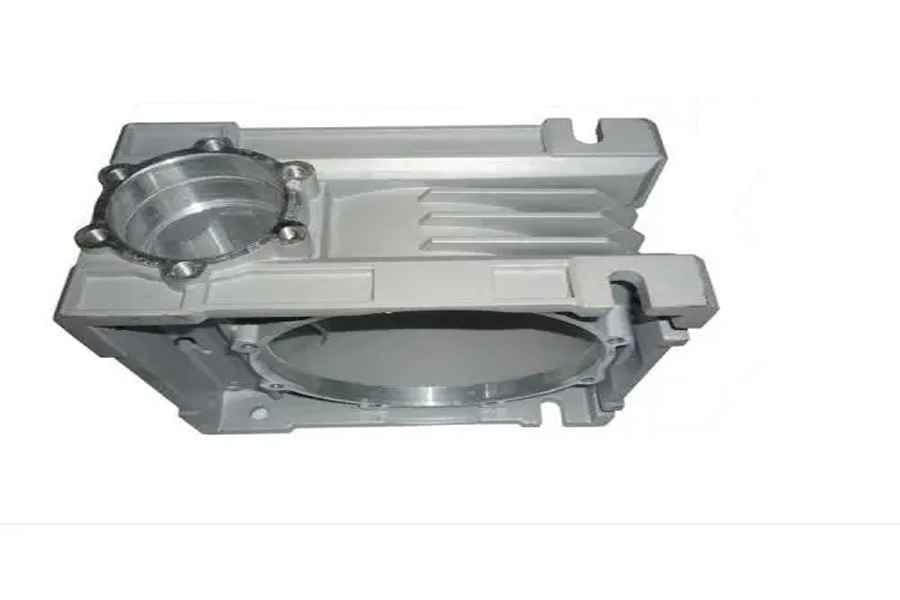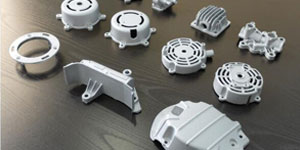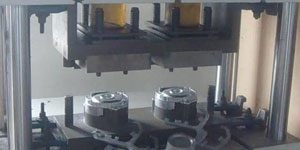1. Stoma
This is a small cavity formed by the gas that has not escaped during the solidification process of the metal. Its inner wall is smooth, contains gas, and has a high reflectivity to ultrasonic waves, but because it is basically spherical or ellipsoidal, That is, it is a point-shaped defect, which affects the reflected wave amplitude. The pores in the steel ingot are flattened into area defects after forging or rolling, which is beneficial to be found by ultrasonic testing.
2. Shrinkage and porosity
When the casting or steel ingot is cooled and solidified, the volume will shrink, and the final solidified part will form a hollow defect because it cannot be supplemented by liquid metal. Large and concentrated voids are called shrinkage cavities, and small and scattered voids are called porosity. They are generally located in the final solidified part of the center of the steel ingot or casting. The inner wall is rough and surrounded by many impurities and small pores. Due to the law of thermal expansion and contraction, shrinkage holes are inevitable, but they have different shapes, sizes and positions depending on the processing methods. When they extend to the casting or ingot body, they become defects. If the steel ingot is not cut off the shrinkage cavity and brought into the forging during the billet forging, it will become the residual shrinkage cavity (shrinkage cavity residue, residual shrinkage tube).
3. Slag inclusion
During the smelting process, the slag or the refractory material on the furnace body peels off and enters the liquid metal, and is involved in the casting or steel ingot body during pouring, forming a slag inclusion defect. Slag inclusions usually do not exist alone, they are often dense or dispersed at different depths. They are similar to volumetric defects but often have a certain degree of linearity. 4. Inclusions
Reaction products (such as oxides, sulfides, etc.) during the smelting process-non-metallic inclusions, or some of the additives in the metal components are not completely melted and remain to form metallic inclusions, such as high-density, high-melting-point components-tungsten , Mo and so on.
5. Segregation
Segregation in castings or steel ingots mainly refers to the composition segregation formed during the smelting process or the metal melting process due to uneven composition distribution. The mechanical properties of the segregated area are different from the mechanical properties of the entire metal matrix, and the difference exceeds the allowable standard The scope becomes a defect.
6. Casting cracks
The cracks in the casting are mainly caused by the shrinkage stress of the metal during cooling and solidification exceeding the ultimate strength of the material. It is related to the shape design of the casting and the casting process, and it is also sensitive to cracking caused by the high content of some impurities in the metal material. Properties related (for example, hot brittleness when sulfur content is high, cold brittleness when phosphorus content is high, etc.). Axial intergranular cracks will also occur in the steel ingots. If they cannot be forged in the subsequent billet forging, they will remain in the forgings and become internal cracks in the forgings.
7. Cold compartment
This is a unique layered defect in castings, which is mainly related to the casting process design of the castings. It is caused by splashing, tumbling, pouring interruption, or two strands (or multiple strands from different directions) when pouring liquid metal. ) The metal flow meets and other reasons, because the semi-solid film formed by the cooling of the liquid metal surface remains in the casting body and forms a diaphragm-like area defect.
8. Flip the skin
This is when the steel ingot is poured from the ladle to the ingot mold during steelmaking. Due to the interruption and pause of the pouring, the surface of the liquid metal poured in the air is rapidly cooled to form an oxide film. When the pouring continues, the newly poured liquid metal will remove it. A delamination (area) defect formed by breaking through and turning into the steel ingot body, it cannot be eliminated by forging in the subsequent billet forging of the steel ingot.
9. Anisotropy
When castings or steel ingots are cooled and solidified, the cooling rate from the surface to the center is different, so different crystalline structures are formed, which is manifested in the anisotropy of mechanical properties, which also leads to the anisotropy of acoustic properties, that is, from the center to the center. The surface has different speed of sound and sound attenuation. The existence of this anisotropy will adversely affect the size and location of defects during ultrasonic testing of castings.

3. Improvement measures
(1) The melting equipment has a poor ability to guarantee the composition of molten iron and the stability of the sand mixing equipment is not good. The composition of molten iron is restricted by many factors such as coke, furnace type, air volume, and raw material conditions; resin sand is affected by factors such as temperature, resin and acid addition. For example, the sand often does not go through the regeneration and cooling bed, so that the temperature of the sand is very high, which seriously affects the strength of the sand mold, causes serious sand expansion in the casting, and increases the tendency of shrinkage and porosity in the casting.
(2) The loose sand in the cavity and the impact of the molten iron during the pouring process directly cause blisters and sand inclusion defects.
(3) There is always slag generated in molten iron in the melting equipment. During pouring, the solid and liquid slag in the molten iron enters the cavity together with the molten iron to form slag holes.
(4) During the production process, the nitrogen content in molten iron increases with the increase of temperature, and decreases with the increase of carbon equivalent. When nitrogen and hydrogen are together, it is easy to form pores, which are the main pores. source.
(5) The rigidity of the mold bottom plate is poor, and the parting surface of the sand mold is uneven when placed before modeling. The gap between the upper and lower parting surfaces is large when the mold is closed, resulting in poor size and shape at the parting surface.
(6) The sand core at the foot of the 2.2m valve body drifts downwards during the pouring process, which is the main cause of uneven wall thickness at the foot.
According to the causes of valve casting defects, we have mainly taken improvement measures from the following aspects:
(1) Appropriately increase the carbon equivalent of molten iron, and use graphitization expansion to enhance the self-feeding ability of the material.
(2) When scouring the box, the compactness of the molding sand is ensured, the strength of the sand mold is improved, and the self-feeding ability of the casting is promoted.
(3) Blow out the loose sand in the cavity before closing the mold, and check the cavity carefully.
(4) The unpoured valve body sand mold is left after on-site pouring, and its sprue cup and vent should be tightly covered to prevent loose sand from entering.
(5) Clean the solid slag on the surface of the molten iron before pouring; increase the initial pouring temperature of the molten iron to reduce the tendency of the molten iron to produce secondary oxidized slag; try to arrange the valve castings to be poured in the initial stage after the furnace is opened to reduce the number of times of lining A large amount of thin slag is generated after use; for 610mm (24in) F body valves, for the cross runner overlap, combined with other parameters during pouring, filter screens are installed at the inlet and outlet, and multiple pieces of lap fiber are filtered The net is improved to a single-piece type to improve the slag retaining effect of the gating system.
(6) Use carbon steel, ordinary gray cast iron or ductile iron as the raw material as far as possible; reduce the content of alloying elements such as Cr and Mn in the molten iron to reduce the gas content of the molten iron; paint all the sand cores before the lower core. It should be stored within a limited time to prevent the sand core from absorbing moisture; in rainy days or seasons with high humidity, it is best to use a blowtorch to bake the surface of the cavity and sand core before setting the core to reduce the amount of gas generated by the sand; use high-temperature pouring small valves, In order to facilitate the self-exhaustion of the molten iron and reduce the generation of slag.
(7) When pouring a 1067mm (42in) F body valve, it is required to pound up and down on the same bottom plate in front of the fixed sand mixer, and there must be no debris on the bottom plate; it is not allowed to put it in other places to reduce Source of variation: It is forbidden to lift the sand mold and the bottom plate together to prevent the bottom plate from being deformed.
(8) When pouring 2.2n, put an appropriate amount of resin sand on the core of the sand core of the foot when pouring the valve body, and mold it as soon as possible.
After taking the above improvement measures, a total of 2413.78 tons of valves were produced throughout the year, with an internal waste rate of 1.15%, an external waste rate of 1.73%, and a comprehensive waste rate of 2.88%. Compared with the scrap rate of valve castings before and after the improvement, the internal scrap rate decreased by 2.39%, the external scrap rate decreased by 2.85%, and the comprehensive scrap rate decreased by 5.24%. The effect is significant.
Please keep the source and address of this article for reprinting: Analysis and Improvement of Common Defects of Valve Castings
Minghe Die Casting Company are dedicated to manufacture and provide quality and high performance Casting Parts(metal die casting parts range mainly include Thin-Wall Die Casting,Hot Chamber Die Casting,Cold Chamber Die Casting),Round Service(Die Casting Service,Cnc Machining,Mold Making,Surface Treatment).Any custom Aluminum die casting, magnesium or Zamak/zinc die casting and other castings requirements are welcome to contact us.

Under the control of ISO9001 and TS 16949,All processes are carried out through hundreds of advanced die casting machines, 5-axis machines, and other facilities, ranging from blasters to Ultra Sonic washing machines.Minghe not only has advanced equipment but also have professional team of experienced engineers,operators and inspectors to make the customer’s design come true.

Contract manufacturer of die castings. Capabilities include cold chamber aluminum die casting parts from 0.15 lbs. to 6 lbs., quick change set up, and machining. Value-added services include polishing, vibrating, deburring, shot blasting, painting, plating, coating, assembly, and tooling. Materials worked with include alloys such as 360, 380, 383, and 413.

Zinc die casting design assistance/concurrent engineering services. Custom manufacturer of precision zinc die castings. Miniature castings, high pressure die castings, multi-slide mold castings, conventional mold castings, unit die and independent die castings and cavity sealed castings can be manufactured. Castings can be manufactured in lengths and widths up to 24 in. in +/-0.0005 in. tolerance.

ISO 9001: 2015 certified manufacturer of die cast magnesium, Capabilities include high-pressure magnesium die casting up to 200 ton hot chamber & 3000 ton cold chamber, tooling design, polishing, molding, machining, powder & liquid painting, full QA with CMM capabilities, assembly, packaging & delivery.

ITAF16949 certified. Additional Casting Service Include investment casting,sand casting,Gravity Casting, Lost Foam Casting,Centrifugal Casting,Vacuum Casting,Permanent Mold Casting,.Capabilities include EDI, engineering assistance, solid modeling and secondary processing.

Casting Industries Parts Case Studies for: Cars, Bikes, Aircraft, Musical instruments, Watercraft, Optical devices, Sensors, Models, Electronic devices, Enclosures, Clocks, Machinery, Engines, Furniture, Jewelry, Jigs, Telecom, Lighting, Medical devices, Photographic devices, Robots, Sculptures, Sound equipment, Sporting equipment, Tooling, Toys and more.
What Can we help you do next?
∇ Go To Homepage For Die Casting China
→Casting Parts-Find out what we have done.
→Ralated Tips About Die Casting Services
By Minghe Die Casting Manufacturer |Categories: Helpful Articles |Material Tags: Aluminum Casting, Zinc Casting, Magnesium Casting, Titanium Casting, Stainless Steel Casting, Brass Casting,Bronze Casting,Casting Video,Company History,Aluminum Die Casting |Comments Off
Link to this article:Analysis and Improvement of Common Defects of Valve Castings
Reprint Statement: If there are no special instructions, all articles on this site are original. Please indicate the source for reprinting.:Cut Wiki,Thanks!^^
